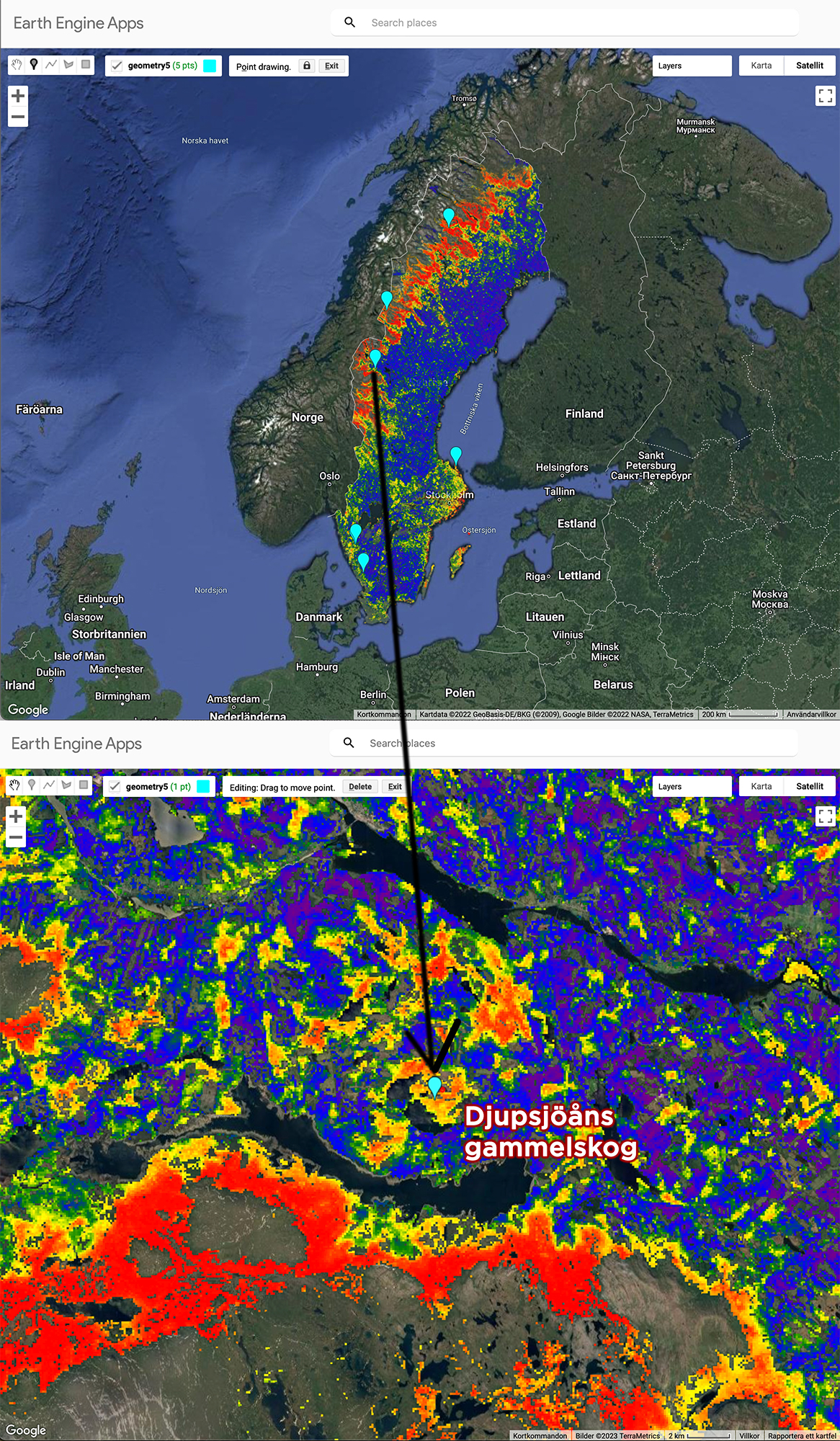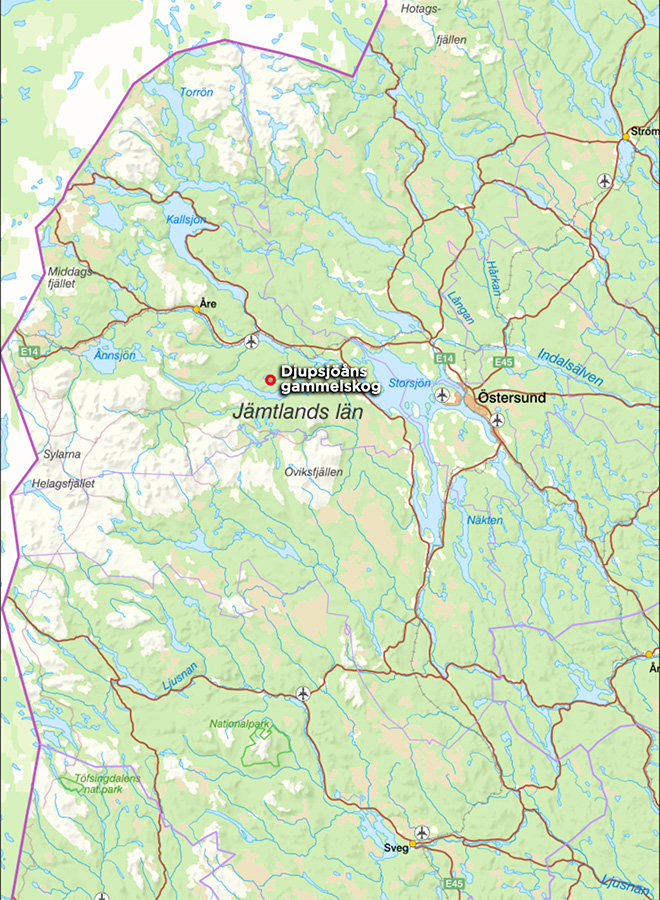Djupsjöån old-growth forest
The property - (click here to show hide)
Naturarvet signed a contract on Djupsjöåns old-growth forest south of Mörsil in Åre municipality, Jämtland, in May and took possession in June 2024. The 192 ha property is located at an altitude of about 500 m above sea level in an extensive forest and moorland area north of Håckrenmagasinet. The forest is bordered by Nördre-Djupsjön in the west and Sönner-Djupsjön in the south and contains the upper half of Djupsjöbäcken, which via two lakes and as many name changes (Luggeån and Gisterån) is a tributary to Indalsälven. In the southeast, the forest borders Djupsjöbäckens nature reserve, whose 57 ha, through cooperation with the County Administrative Board of Jämtland, is expanded with the 192 ha of the Nature Heritage.
We are humbly grateful that this property was for sale and that we had previously received several large gifts that made it possible to acquire the property. Through the cooperation with the County Administrative Board in Jämtland County, part of the funding will come at the time of the decision on the Nature Reserve. To contribute to the remaining fundraising see below.
Nature - (click here to show hide)

Djupsjöån's old-growth forest is a large and, from a nature value point of view, very valuable area, in a jointly designated by the Swedish Forest Agency and the County Administrative Board for forest biological nature values, consisting of forest environments, wetlands and aquatic environments. The low degree of human impact together with the size of the area is a very unusual feature in today's forest landscape. Together with the adjacent Djupsjöbäcken nature reserve, it forms a contiguous natural forest area of just over 250 hectares with very high natural values. This area is in turn part of an approximately 1000-hectare mosaic natural forest area classified as an independent enclave of the mountain chain's coherent mountain forest belt with high natural values.
The primeval forest areas consist of; 1. Grand-dominated natural forest dominates with plenty of old trees and both standing and lying dead wood. These often have a noticeable element of old pines and deciduous trees. 2. the pine-dominated areas are clearly characterized by fire and are in places primeval forests with several different generations of living pines, the oldest of which often have traces of many different fires; 3. the deciduous tree richness is relatively high throughout the area, but especially west of Lapptjärnen large areas of deciduous trees are spreading out. Both pine forests and deciduous forests are clearly affected by the last major fire in the area 120 years ago.
The County Administrative Board has made an inventory in 2020 and Naturarvet has supplemented in 2024. Here is a selection of species found:
- Beaver Castor fiber LC
- Otter Lutra lutra NT
- Great Loon Gavia arctica LC
- Little Grebe Gavia stellata NT
- Wolverine Tetrastes bonasia NT
- Capercaillie Tetrao urogallus LC
- Drillbit Actitis hypoleucos NT
- Three-toed Woodpecker Picoides tridactylus NT
- Black woodpecker Dryocopus martiusNT
- Grey woodpecker Picus canus LC
- Lichen jay Perisoreus infaustus LC
- Lesser celandine Fraxinus excelsior LC
- Common swift Apus apusEN
- Common midge Troglodytes troglodytes LC
- White-throated sparrow Emberiza rustica NT
- Greenling Picus viridis LC
- White-faced needlewort Chaenotheca subroscida NT
- Glossy black spike lichen Calicium denigratum NT
- Kolflarnlav Carbonicola anthracophila NT
- Shrimp lichen Alectoria sarmentosa NT
- Knotted bladderwort Hypogymnia bitteri NT
- Wood flame lichen Ramboldia elabens NT
- Scab jellyfish Rostania occultata NT
- Hull lichen Lobaria scrobiculata NT
- Coral lead lichen Parmeliella triptophylla Signal species
- Stool lichen Nephroma bellum Signal species
- Hairy lichen Nephroma parile Signal species
- Norway spruce Pseudographis pinicola NT
- Woolly tick Phellinidium ferrugineofuscum NT
- Spruce bark beetle Porodaedalea chrysoloma NT
- Rosenticka Rhodofomes roseus NT
- Eastern tick Skeletocutis odora VU
- Wrinkled skin Phlebia centrifuga VU
- Fragrant tick Haploporus odorus VU
- Spider flowers Neottia cordata Signal species
Climate - (click here to show/hide)
106 ha of the area is productive forest land, most of which is old coniferous natural forest, a smaller part is an old deciduous burn with a large element of leaves such as birch and willow. According to a forest management plan from August 2023, 50 ha of the old forest is proposed to be harvested within two years. In 20 years, another 50 ha could be felled. With Naturarvet acquiring the forest, the felling will never happen. The direct climate benefit of this is equal to 0.25% of Sweden's entire annual CO2 emissions from domestic transportation.
Protecting the Djupsjöån river old-growth forest and other similar old-growth forests is the most important action we can take locally to slow down climate change globally.
The collection
To the Fundraising pageIn May 2024, the contract was signed and the down payment was paid. Through strong fundraising in the fall of 2023 and spring of 2024, we have already raised part of the purchase price. To finance the purchase, Naturarvet borrowed SEK 4 million from private lenders. The government will disburse SEK 4 million in September 2024 to repay the loans. To cover all costs, including ongoing costs for fundraising and administration, at least another SEK 3 million is required. All surplus will of course go to the acquisition of the next old-growth forest somewhere in Sweden. Contribute to the collection for Djupsjöåns old-growth forest!
- Click here to save one or more forest plots!
- Click here to join forest patron - Natural Heritage's main backbone of donors!
- Click here to give a gift - old-growth forest in gift suitable for all occasions!
- Click here to contribute to the fundraiser in any way you like!
How to get here - (click here to show/hide)
Djupsjöåns old-growth forest is located about 500 meters above sea level in an enclave of Krokom in Åre municipality, Jämtland. The nearest town is Mörsil about 15 km by bike / car. The forest can be reached via the public road network and a shared road that takes you to either the eastern part of the area via Djupsjöbäckens nature reserve where parking is done at a road barrier, to the western part via a private road at the end, which is usually not tolled, or to the south side of Sönner-Djupsjön for those who want to enter the area over the lake by boat / canoe or skis.
By public transport you can get from Sundsvall/Östersund by train to Åre/Duved/Storlien and from Östersund by bus to the same destination to Mörsil railway station, from where you can cycle (about 1 hour) or walk (about 3 1/2 hours) to the area.
Remember to respect the right of public access and not to disturb the privacy of residents and holidaymakers in the area. Do not park on or enter roads and land that are private. You are responsible for vehicles that may be damaged by driving on bad roads.
